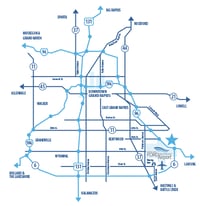Innovative Natural Treatment System will Remove Pollutants, Help Keep River Clean
Grand Rapids, MI (March 28, 2013) – Gerald R. Ford International Airport (GFIA) will build a natural treatment system to improve stormwater management practices and safeguard the waters of the Thornapple River, Executive Director Brian Ryks announced.
Speaking today before the Kent County Board of Commissioners, Director Ryks detailed a plan to construct a biological treatment system that will improve collection of stormwater runoff and naturally remove sediments and pollutants before sending the water to the Thornapple River, which flows just east of the airfield. The current approach basically delivers much of the airport’s raw stormwater to a small tributary of the Thornapple.
“The Thornapple River system is a remarkable waterway that must remain clean and healthy,” Director Ryks said. “This new green infrastructure is a cost-effective approach to improve the airport’s environmental performance and help sustain the river’s water quality, aquatic life, and natural beauty.”
Stormwater runoff occurs when precipitation from rain and snowmelt flows over roads, parking lots, airport aprons, and other hard surfaces that prevent water from naturally soaking into the ground. As it drains to nearby waterways runoff can pick up debris, sediments, chemicals, and other pollutants and – absent proper management techniques – serve as a source of degradation to waterways such as the Thornapple River and its tributaries.
Managing runoff that contains aircraft de-icing fluid is a particularly unique challenge at Ford International. The Federal Aviation Administration for safety reasons requires aircraft and pavement deicing as necessary during cold weather months. The airlines at Ford International use propylene glycol, an organic compound that’s commonly used as a food additive and in personal hygiene products.
Propylene glycol can have environmental implications. The compound, for example, is highly biodegradable. Algae, fungi, and other aquatic organisms can feed and thrive on glycol in certain ecological conditions. Therefore managing runoff that contains glycol is a top priority.
“We’ve steadily reduced the amount of de-icing fluid that stormwater carries away,” Director Ryks said. “Indeed, the amount of fluid we vacuum off the airport apron before it reaches the storm drain consistently exceeds forthcoming U.S. Environmental Protection Agency guidelines. But we continuously aspire to improve our operation.”
GFIA engaged the nation’s preeminent glycol expert and established an advisory committee – a volunteer group of airport neighbors, environmentalists, airline representatives, economic development leaders and others – to develop a long-term plan of action for responsibly managing stormwater runoff that contains aircraft de-icing fluid.
The Stormwater Advisory Committee analyzed a range of options for action to ensure regulatory compliance and deliver heightened environmental benefits. The recommended longterm solution, which the Michigan Department of Environmental Quality endorses, is to construct a biological treatment system. This system is designed with vegetated beds that, acting like kidneys, will absorb de-icing fluids and other pollutants as the stormwater passes through the root system.
GFIA also will continue to collect and recycle as much de-icing fluid as feasibly possible.
“When compared to our existing system this new approach will reduce the overall amount of de-icing fluids and other pollutants going to the Thornapple River under similar winter conditions,” Director Ryks said. “The airport will meet and where feasible exceed the highest environmental protection standards.”
Construction is scheduled to begin in late 2013 and be completed in late 2015.



